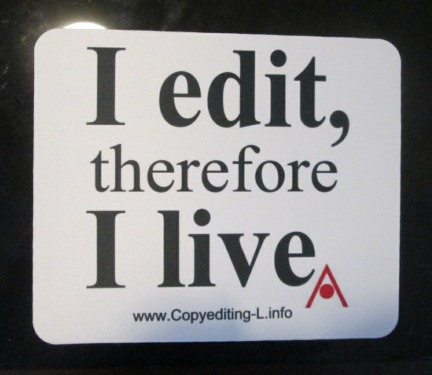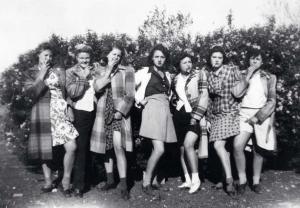A very long while back, like in May 2015, I started an occasional series devoted to Sturgis’s Laws. “Sturgis” is me. The “Laws” aren’t Rules That Must Be Obeyed. Gods forbid, we writers and editors have enough of those circling in our heads and ready to pounce at any moment. These laws are more like hypotheses based on my observations over the years. They’re mostly about writing and editing, but I can’t help noticing that some of them apply to other aspects of life as well. None of them can be proven, but they do come in handy from time to time.
It’s been more than three and a half years since I blogged about Sturgis’s Law #10, and I’m only halfway through the list. Time to get cracking! As I blog about them, I add the link to Sturgis’s Laws on the drop-down from the menu bar. Here at long last is Sturgis’s Law #11:
The burden of proof is on the editor.
We editors live to make good prose better and awkward prose readable. We mean well and most of us are at least pretty good at what we do, but this has its downside: the writers we deal with are usually pretty good at what they do, and even when they’re not, they generally have a better idea of what they’re trying to get across than we do.
Newly fledged editors can be a bit, well, full of ourselves. I sure as hell was. I got hired for my first professional (i.e., paid) editor job on the basis of my knowledge of English grammar, usage, spelling — the basics, in other words. I was quickly introduced to “Chicago style,” which then in its 12th edition was still called A Manual of Style. (It became the Chicago Manual of Style with the 13th edition and so it’s continued through the 17th and current one.)
Oh dear! So many recommendations to remember and apply! I learned, I applied — and I got pretty obnoxious about some of it, notably the which/that distinction: That is used for restrictive clauses, which for non-restrictive, and which is invariably preceded by a comma. Thus —
The house that I grew up in had green shutters.
That house, which was built in 1956, is the one I grew up in.
In the first example, “that I grew up in” provides information essential to identifying the house. In the second, “which was built in 1956” is almost an aside: you could put it in parentheses or drop it completely. (For what it’s worth, the house I grew up in was built in 1956, but it had no shutters at all.)
Never mind that I’d lived almost three decades and learned to write pretty well knowing zip about the which/that distinction — now it became my litmus test for sorting writers into categories: those who “got it” and those who didn’t. This stood me in good stead when, almost two decades later, I started freelancing for U.S. publishers, because many of them include the which/that distinction in their house style, plus it’s in Chicago, which most of them use as a style guide.
Long before that, however, I’d learned that in British English “which” is often used for restrictive clauses and little if any confusion results; it also dawned on me that the distinction between restrictive/essential and non-restrictive/non-essential often isn’t all that important to the sentence at hand. Consider, for instance, the convention for setting off non-essential words with commas. I’m supposed to write “My dog, Tam, likes to ride in the car” because (1) I’ve only got one dog, and (2) it’s important that the reader know that. True, I’ve only got one dog, but if it’s important that the reader know this I’m not going to rely on commas to get the idea across. Besides, that’s an awful lot of commas for a short sentence.
I also learned that in turning which/that into a litmus test, I was acting perilously like the English-language grammarians and educators in the mid to late 19th century. Concerned by increasing literacy among the working classes, they came up with a bunch of rules to distinguish the properly educated from the riffraff. Most of those “rules,” like the injunction against splitting an infinitive or ending a sentence with a preposition, have been properly consigned to the dungheap by good writers and editors. Nevertheless, they’re tenacious enough to have been dubbed “zombie rules” because they don’t stay dead.
While that first editorial job introduced me to the potential for editorial arrogance, it also presented a couple of antidotes. One was Theodore Bernstein’s The Careful Writer: A Modern Guide to English Usage. My paperback copy is in two pieces from years of frequent consultation. Since it was first published in the mid-1960s, it’s no longer quite as “modern,” but it’s still a good antidote for editors, educators, and other word people who are sometimes tempted to take ourselves and our esoteric knowledge a little too seriously. Bernstein is also the author of Miss Thistlebottom’s Hobgoblins: The Careful Writer’s Guide to the Taboos, Bugbears, and Outmoded Rules of English Usage, which I think is still in print.
Most important, that job required that each manuscript be “cleared”: you sat down side by side with the writer and went through the whole ms. line by line, answering the writer’s questions and explaining why you’d made this or that change. (These were pamphlets, brochures, training manuals, and such, ranging up to perhaps 40 pages in length, not full-length books.) These writers weren’t pros. Some were definitely more capable than others, and it wasn’t uncommon for the less capable to be the most defensive about edits. I learned to justify every change I made to myself so that I could explain it clearly to the writer.
When freelancing for trade publishers these days, I have zero direct contact with the authors of the book-length mss. I work on, but I know they’re going to see the edits I make and the queries I write. On most other jobs, I do deal directly with the author, but almost exclusively by email. That early experience has stood me in very good stead over the decades: I never forget that there’s a real human being on the other side of the manuscript.
For more about that first staff editor job, including how I got that T-shirt, see “1979: I Become an Editor” in my new blog, The T-Shirt Chronicles.









 Why do you write flash? What makes it different for you?
Why do you write flash? What makes it different for you?

 By Allison Coffelt
By Allison Coffelt
